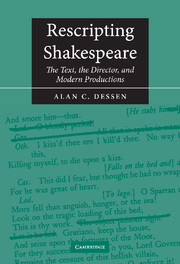Book contents
- Frontmatter
- Contents
- Acknowledgments
- Note on documentation
- List of abbreviations
- 1 “Let it be hid”: price tags, trade-offs, and economies
- 2 Rescripting Shakespeare's contemporaries
- 3 Adjustments and improvements
- 4 Inserting an intermission/interval
- 5 What's in an ending? Rescripting final scenes
- 6 Rescripting stage directions and actions
- 7 Compressing Henry VI
- 8 The tamings of the shrews: rescripting the First Folio
- 9 The editor as rescripter
- Conclusion: what's not here
- Appendix: productions cited
- Notes
- Index
1 - “Let it be hid”: price tags, trade-offs, and economies
Published online by Cambridge University Press: 22 September 2009
- Frontmatter
- Contents
- Acknowledgments
- Note on documentation
- List of abbreviations
- 1 “Let it be hid”: price tags, trade-offs, and economies
- 2 Rescripting Shakespeare's contemporaries
- 3 Adjustments and improvements
- 4 Inserting an intermission/interval
- 5 What's in an ending? Rescripting final scenes
- 6 Rescripting stage directions and actions
- 7 Compressing Henry VI
- 8 The tamings of the shrews: rescripting the First Folio
- 9 The editor as rescripter
- Conclusion: what's not here
- Appendix: productions cited
- Notes
- Index
Summary
“a short tale to make”
Polonius, 2.2.146In the final speech of Othello Lodovico issues the command: “The object poisons sight,/Let it be hid” (5.2.364–65). According to scholars who gloss the line, “the object” and “it” refer to the bodies of Othello and Desdemona (“the tragic loading of this bed” – 363). Jacobean beds had curtains whereas our beds do not, so that in those first performances at the Globe the poisoned sight could be hidden after Lodovico's line by closing a bed curtain, an option usually not available today. Recent directors, moreover, resist such closing off of the two or three dead figures on the bed because they prefer to have that tragic loading the final image as the lights go down (such diminution of onstage illumination was not possible at the Globe), often accompanied by an onlooking Iago. The preferred choice today is therefore to treat Iago rather than the figures on the bed as the object that poisons sight and direct him to be “hid” or taken offstage. Furthermore, directors such as Brian Bedford (SFC 1991) and Michael Attenborough (RSC 1999) have chosen to keep Iago as an onstage observer of an Othello and Desdemona still visible on the bed. Their solution is worthy of Alexander the Great with the Gordian knot: cut “Let it be hid.”
- Type
- Chapter
- Information
- Rescripting ShakespeareThe Text, the Director, and Modern Productions, pp. 1 - 37Publisher: Cambridge University PressPrint publication year: 2002



